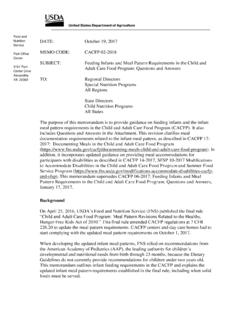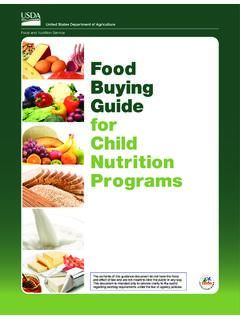Transcription of Crediting Handbook for the Child and Adult Care Food …
1 United States Department of Agriculture Crediting Handbook for the Child and Adult care food Program The Department of Agriculture prohibits discrimination against its customers, employees, and applicants for employment on the bases of race, color, national origin, age, disability, sex, gender identity, religion, reprisal, and where applicable, political beliefs, marital status, familial or parental status, sexual orientation, or all or part of an individual's income is derived from any public assistance program, or protected genetic information in employment or in any program or activity conducted or funded by the Department. (Not all prohibited bases will apply to all programs and/or employment activities.). If you wish to file a Civil Rights program complaint of discrimination, complete the USDA Program Discrimination Complaint Form, found online at , or at any USDA office, or call (866) 632-9992 to request the form.
2 You may also write a letter containing all of the information requested in the form. Send your completed complaint form or letter to us by mail at Department of Agriculture, Director, Office of Adjudication, 1400 Independence Avenue, , Washington, 20250-9410, by fax (202) 690-7442 or email at Individuals who are deaf, hard of hearing or have speech disabilities may contact USDA through the Federal Relay Service at (800) 877-8339; or (800) 845-6136 (Spanish). USDA is an equal opportunity provider and employer. Acknowledgments T he original publication Crediting Foods for the Child and Adult care food Programs was published by the Nutrition and Technical Services, food and Nutrition Service (FNS), USDA, Mountain Plains Region and was updated by the FNS Mid-Atlantic Region and FNS Headquarters.
3 We wish to acknowledge the following individuals for their contributions: Colorado Department of Health; Beth Wetherbee (retired) of the Delaware Department of Public Instruction; Carol Fettweis and Carol Loomis of the Maryland Department of Public Instruction;. Molly Wood, Gloria Cunningham, and Robin Ziegler of the Maryland Department of Education;. Joyce Soroka and Susan Still of the Pennsylvania Department of Education; Lucy Gerland of the Fairfax, Virginia, County Department of Family Services; Elizabeth Henry of the Prince William County, Virginia, County Social Services; Jan McCullough of the Fairfax, Virginia, County Department of Family Services; Karen Mellon of the Fairfax, Virginia, County Office of Administration for Human Services; Debra Moore, , from Places and Programs for Children.
4 Ellen Anderson of the food and Drug Administration, Office of food Labeling; Marlene Stein and Michele Bouchard (no longer with FNS) of the FNS Mid-Atlantic Regional Office; and Melissa Magee of the FNS Mountain Plains Regional Office. We also wish to thank Donna Blum as well as the Nutrition Promotion and Technical Assistance Branch, especially Sonya Barnes, at FNS headquarters. 1. Table of Contents Introduction .. 4. CACFP Meal patterns .. 10. 14. Meat/Meat Alternates .. 20. Vegetables/Fruits .. 32. Grains/Breads .. 45. Crediting Combination Foods .. 61. Crediting Commercial, Frozen, or Canned 62. 2. Table of Contents Crediting Popular Foods .. 63. General Guidance for Menu Planning .. 64. Suggestions for Preparing Preschool Children for meals Served in HealthierUS Schools.
5 66. Ways To Encourage Children To Have Positive Attitudes Toward 70. Safety and Sanitation Tips .. 71. Sample Product Formulation Statement .. 73. 3. Introduction T he goal of the Child and Adult care food Program (CACFP) is to improve the health and nutrition of children and adults in the program, while promoting the development of good eating habits through nutrition education. The food Buying Guide for Child Nutrition Programs (FBG) is the principal tool with which to determine the contribution that foods make toward meal requirements regardless if foods are produced on site or purchased commercially. This Handbook is a supplementary resource with additional information on creditable foods in Child and Adult care centers, outside-school-hours care centers, and family day care homes.
6 Since the previous updates, there have been a number of changes in products, a wider variety of foods used in our programs, and advances in the areas of human nutrition and food service. Additionally, the Dietary Guidelines for Americans 2010 emphasize the importance of choosing foods that are lower in saturated fats and trans fats, eating nutrient dense foods, and incorporating more fruits, vegetables, and whole grains into our diets. We encourage menu planners to follow these principles when planning Child and Adult care food Program menus. This book is a companion to the food Buying Guide for Child Nutrition Programs (FBG). It does not replace the food Buying Guide. Therefore, as a reminder, when using the 2001 food Buying Guide, please ensure that your copy includes the FY 2003 pen and ink changes or replacement pages.
7 If you do not have these changes, please contact your FNS Regional Office or State agency for these updates. The revised edition and the replacement pages may also be downloaded at tn/foodbuying-guide- Child -nutrition-prog rams. Please be aware that some sections of the FBG have been revised for school meal programs. These revised sections should not be used for Child care settings. This publication does not include guidance concerning CACFP infant meal patterns or feeding. For information on infant feeding, please contact your State agency (SA) or family day care home sponsoring organization. The infant meal patterns may be viewed at: The lists of creditable and noncreditable foods in this publication are not all-inclusive. This publication includes only those foods that are commonly served in Child care programs and foods we have received inquiries about or have noted as being credited incorrectly.
8 4. Introduction The following terms are used throughout this Handbook : Creditable foods: Foods that may be counted toward meeting the meal pattern requirements for a reimbursable meal. They are or they contain creditable foods as listed in the FBG; They are in compliance with regulations governing the Child Nutrition Programs (in quantity requirements and/or by definition);. They are in compliance with the food and Drug Administration's (FDA) Standards of Identity;. They are in compliance with USDA's standards for meat and meat products (if applicable); and They are in compliance with administrative policy decisions on the Crediting of popular foods. Noncreditable foods: Foods that do not count toward meeting meal pattern requirements because they do not meet criteria.
9 Nevertheless, noncreditable foods often supply additional nutrients and calories that help meet the energy and nutritional needs of participants. For example, the service of a protein-rich food (such as eggs) at breakfast is not required but it contributes additional nutrients, improves the acceptability of meals , and satisfies appetites. The United States Department of Agriculture (USDA) reimburses Child and Adult care centers, family day care home sponsors, at-risk after school snack programs, and homeless shelters participating in the CACFP for the meals served to young children or Adult enrollees, not for individual foods. A meal is reimbursable if it contains those creditable foods in the amounts outlined in the CACFP meal patterns .
10 5. Definitions and Explanations Alternate Protein Products (APP). food ingredients that may be used to substitute in part or in full for meat, poultry, or seafood. These products must meet the requirements for Alternate Foods for meals , Appendix A of the Code of Federal Regulations (CFR) Book 7, Part 226. These products do not include tofu, surimi, seitan, or tempeh. Before using APP products and claiming the meals for reimbursement, contact your food and Nutrition Service (FNS) Regional Office and/or State agency. Please see page 21. and the questions and answers in the meat/meat alternate section. Child Nutrition (CN) Label A voluntary component of the Federal labeling program for the Child Nutrition Programs. Provides a warranty for CN-labeled products for auditing purposes if the product is used according to manufacturer's directions as printed on the approved CN label.



